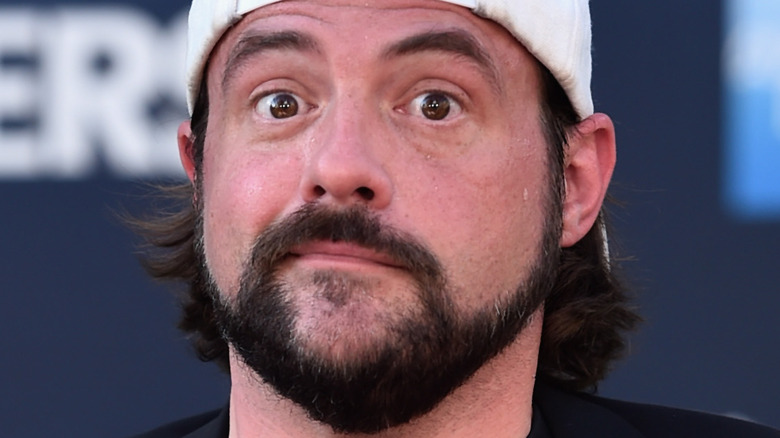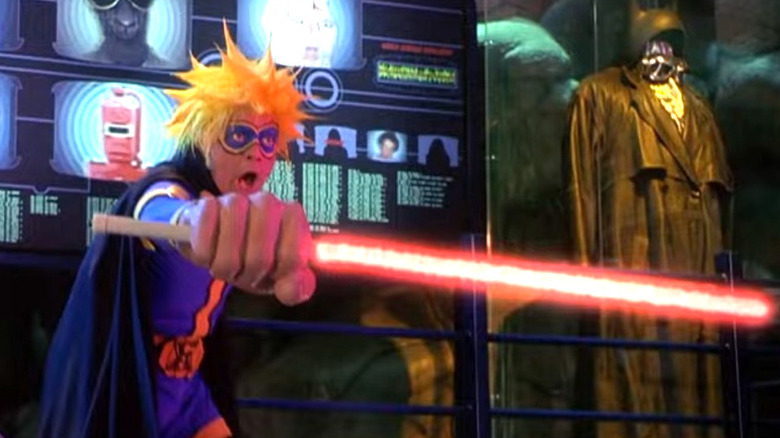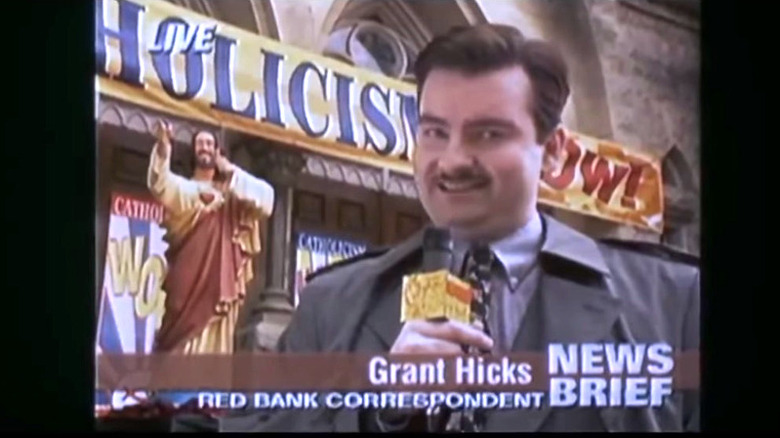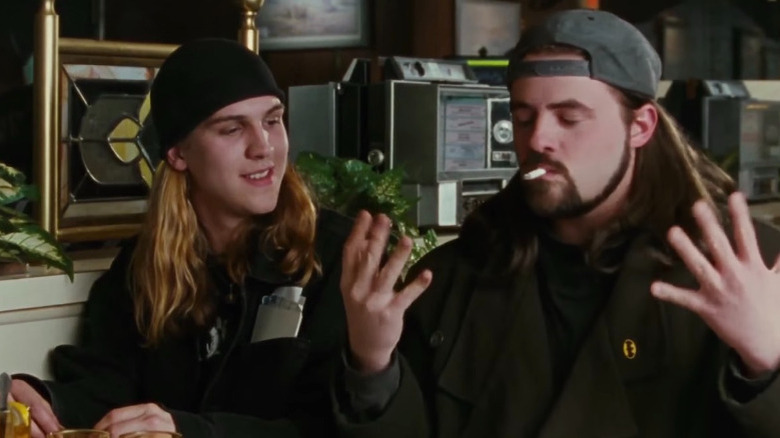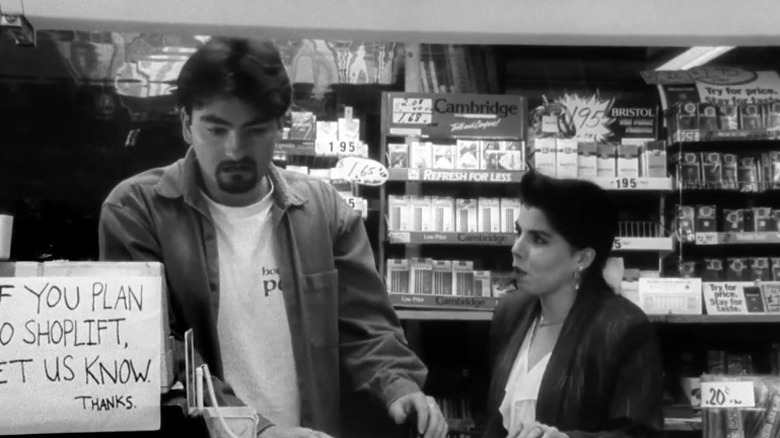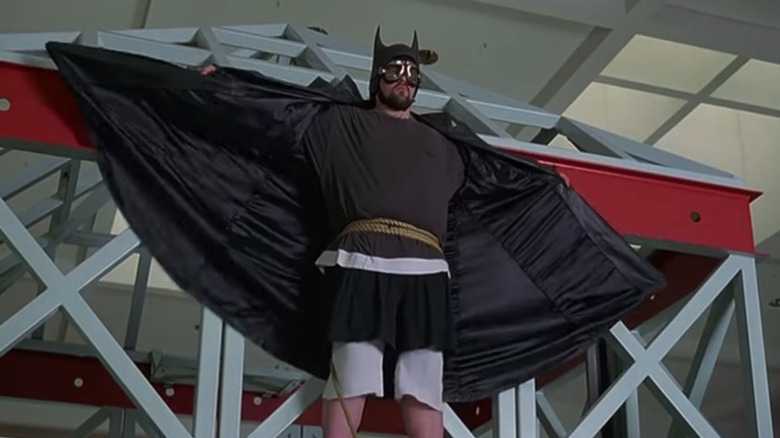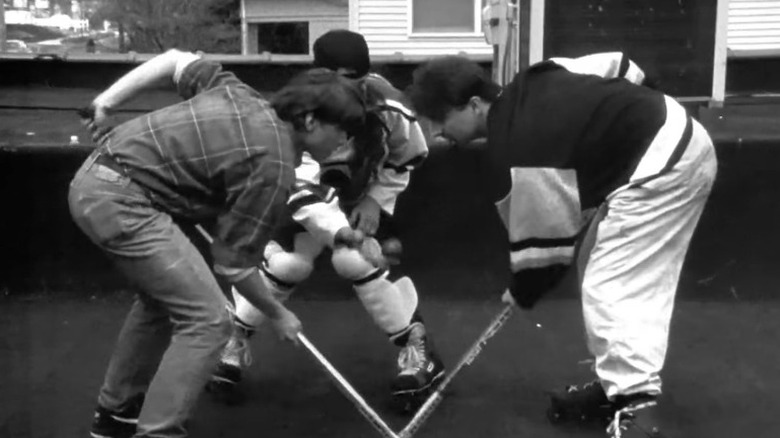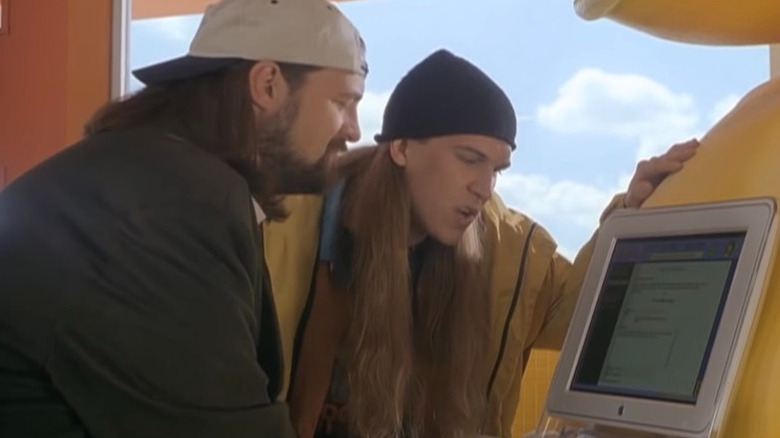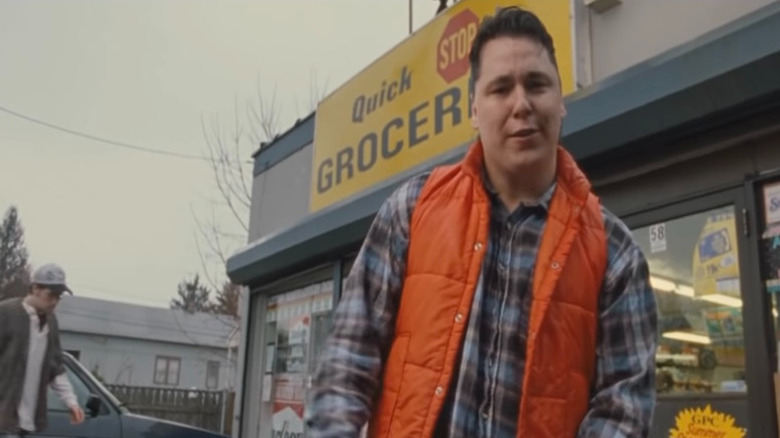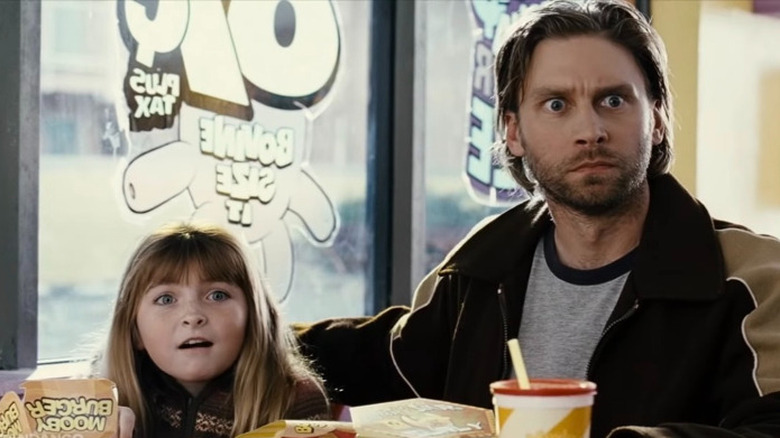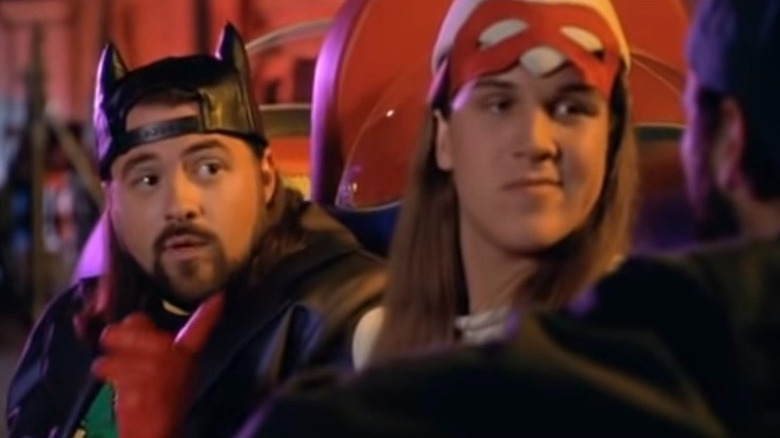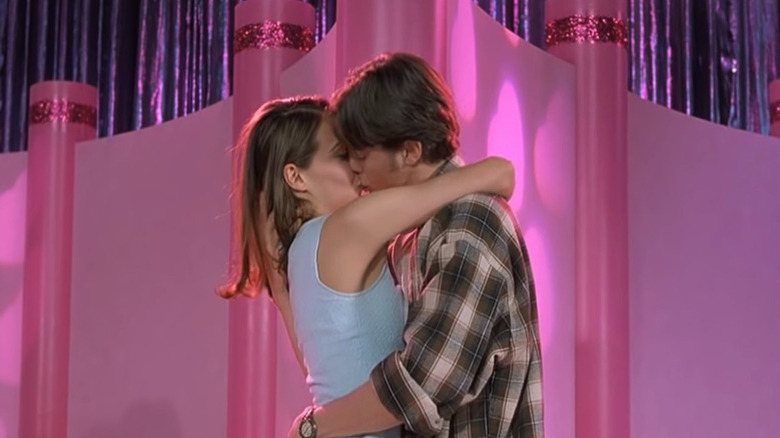Things That Happen In Every View Askewniverse Movie
Beginning with "Clerks" in 1994, writer-director Kevin Smith built his own cinematic universe, primarily set in the suburbs of New Jersey. Named after his View Askew production company, the View Askewniverse developed over almost 30 years and seven movies, including "Mallrats," "Chasing Amy," "Dogma," "Jay and Silent Bob Strike Back," "Clerks II," and "Jay and Silent Bob Reboot." With the exception of the three "Clerks" films and the two "Jay and Silent Bob" movies, which are sequels, the other movies in the universe stand completely on their own.
You don't need to watch every View Askew film to understand the others. Although certain characters and references carry through the entire timeline, they're not interconnected in such a way that requires you to be an expert on all the events happening in or around New Jersey. If you do take the entire ride from start to finish, though, it can be a fun and rewarding experience.
Like the filmography of any auteur, part of the fun in watching so many of their movies is recognizing what carries over from film to film. That's what we're doing in this article: pointing out and discussing all the major motifs that occur over the span of the entire View Askewniverse. We're leaving out things like references to New Jersey or contemporary music cues, because the former is the setting for the universe itself and the latter is just a part of filmmaking. That said, let's dive into the Askewniverse...
Star Wars references
One of the pop culture phenomena that Kevin Smith has a fixation with is "Star Wars." The director has found ways to bake his adoration for the space saga into the DNA of his films. In "Clerks," Dante and Randal (Brian O'Halloran and Jeff Anderson) discuss the endings of both "The Empire Strikes Back" and "Return of the Jedi" in detail, summing up how they feel about them.
While Dante feels "Empire" is superior for its downbeat ending, Randal is bothered by the sacrifice of independent contractors brought in to work on the second Death Star who lost their lives when Lando blew it up. A similar scene occurs in "Chasing Amy," when independent comic creator Hooper (Dwight Ewell) goes on a faux rampage after explaining that revealing Darth Vader to be white suggests that all black people want to be white, which Banky Edwards (Jason Lee) claims to believe is true.
There are smaller references in "Mallrats" (Silent Bob tries to do the Jedi mind trick and quotes Yoda) and "Dogma" (Jay compares sitting in a diner with Bethany — Linda Fiorentino — to the cantina sequence), while a discussion in "Clerks II" dissecting "The Lord of the Rings" features some criticism of Hayden Christensen. The title of "Jay and Silent Bob Strike Back" is a "Star Wars" reference (plus Mark Hamill and Carrie Fisher both make cameos), while Jay's daughter in "Jay and Silent Bob Reboot" is named — wait for it — Millennium Falcon.
Brian O'Halloran appearances
Kevin Smith likes to remain loyal to his actors. The same performers will appear in his films as multiple characters. Jason Lee plays both Brodie Bruce in "Mallrats" and Banky in "Chasing Amy." Ben Affleck plays the villain in "Mallrats" and "Dogma" while taking the lead in "Chasing Amy," playing a customer in "Clerks II" and himself in "Jay and Silent Bob Strike Back." Only one actor (besides Smith himself and Jason Mewes) has appeared in every View Askew movie: Brian O'Halloran.
O'Halloran was Dante Hicks in "Clerks." Dante is, of course, also in "Clerks II," but he also appears at the beginning of both "Jay and Silent Bob Strike Back" (along with the hilarious ape conspiracy sequence), and the beginning and end of "Jay and Silent Bob Reboot." In "Mallrats," he plays a relative of Dante and contestant on "Truth or Date," Gill Hicks. In "Dogma" he can be seen as yet another member of Dante's family, "News Brief" reporter Grant Hicks.
His cameo in "Chasing Amy" is a little harder to spot because it goes by so quickly and he looks a little different (thanks to a ponytail). In the film, Holden and Banky are the creators of a hit underground comic called "Bluntman and Chronic." A television network with young, hip executives (very MTV) wants to turn the characters into an animated series. During a meeting with this network, one executive is played by Matt Damon and the other is, obviously, Brian O'Halloran.
Jay and Silent Bob guide us through the View Askewniverse
Certain actors reappear throughout the View Askewniverse in multiple roles, but Jay and Silent Bob are always played by Jason Mewes and Kevin Smith. We first meet them as simple drug dealers peddling their wares outside of Quick Stop in "Clerks." The next time we see them, they're in the local mall in "Mallrats," hanging out in front of a pet store and occasionally dealing, but mostly trying to help out their buddies Brodie and T.S. whenever they can. They only have one scene in "Chasing Amy," but it's a pivotal moment for the film and its main character.
In "Dogma," the pair are on a mission from God to help prevent fallen angels from entering a church and negating all existence (although really, they're just hoping to have sex with the protagonist, played by Linda Fiorentino). "Jay and Silent Bob Strike Back" is their movie: they take us back through the View Askewniverse by visiting with some of our favorite characters, before heading off on an all-new adventure to stop Hollywood from making a movie based on them (kind of). With "Clerks II," they're back with Dante and Randal, hanging outside their place of work.
They star again in "Jay and Silent Bob Reboot," where they have to stop Hollywood from rebooting a movie about them (kind of). In the end, it just isn't a View Askew movie without the dynamic duo of Jay and his hetero-lifemate Silent Bob.
Relationship trouble
The best entries in the View Askewniverse are about how complicated love can be. This usually, but not always, means romantic love. For instance, "Clerks" and "Chasing Amy" are about a man's feelings of inadequacy when discovering the truth of his girlfriend's past. Dante is all cocky about his proficiency at intimacy and number of sexual partners until he demands his girlfriend Veronica (Marilyn Ghigliotti) reveal the number of people she's performed sexual favors for. Plus, his ex-girlfriend Caitlin (Lisa Spoonauer) is still in his life and showing signs of wanting to get back together — even though she's about to get married to someone else.
"Chasing Amy" sees Holden McNeil putting his heart on the line for a sexually fluid woman who has had encounters way beyond his prude comprehension. They're great because they feel honest, as though Smith were grappling with this insecurity himself (and if you're a "Smodcast" listener, you'll know he was). "Mallrats" features two men trying to repair their romantic relationships, while "Clerks II" has Dante torn between his fiance and his boss. "Jay and Silent Bob Strike Back" sees Jay willing to give up everything for a jewel thief.
"Dogma" and "Jay and Silent Bob Reboot" are a little different. In "Dogma," Bethany is repairing her relationship with God. In the latter, Jay can't quite figure out how to connect with the daughter he never knew he had.
Comic book references
Kevin Smith also makes sure that his comic book addiction is on full display in every film. With the exception of "Clerks," most of these references are pretty easy to spot. Both "Mallrats" and "Chasing Amy" have comics all over the place, characters talk about them at length, there's comic book artwork showing up everywhere, and Stan Lee even plays himself. The same is mostly true for "Jay and Silent Bob Strike Back" and "Reboot," since a comic book store, a convention, and movies about superheroes feature heavily in their plots.
In "Clerks" and "Clerks II," the references are sometimes subtler. During the finale of "Clerks II," Randal ridicules the fact that he and Dante were basically trying to become Batman when they took criminology in college. In "Clerks," there's a copy of "Heavy Metal" on the video store shelf (which was inspired by the comic book magazine), and the guidance counselor testing eggs (Walt Flanagan) has Reed Richards-style gray temples.
One of the demon kids in "Dogma" is wearing a "Hellboy" T-shirt, and Smith thanks Neil Gaiman and Alan Moore in the credits. Also, one of the influences on Silent Bob's name was Bob the Goon in Tim Burton's 1989 "Batman," as Smith pointed out during his audio commentary for the film.
Hockey love
Hockey can be a harder Kevin Smith obsession to spot. The only movie to feature characters actually playing hockey is the iconic scene from "Clerks" when Dante is forced to take his friends to the roof of Quick Stop to play. Even though there aren't any explicit, in-your-face references to hockey in the other films, something related to the game itself is seen at some point in each subsequent film.
In "Mallrats," Jay uses a hockey stick to knock out the Eden Prairie Mall security guard LaFours to save T.S. and Brodie. Alyssa Jones (Joey Lauren Adams) wears a hockey jersey in one scene from "Chasing Amy." The Stygian Triplets in "Dogma" ride around on rollerblades and wield hockey sticks as weapons. Randal wears a hockey jersey in "Jay and Silent Bob Strike Back" and carries a stick in "Clerks II." Jay's daughter Milly (Harley Quinn Smith) wears a hockey mask and uses a stick to knock both him and Silent Bob out in "Jay and Silent Bob Reboot." The references are there — all you have to do is look.
Salty dialogue
All the View Askew movies are rated R for a reason: Kevin Smith loves him some curse words. Not only is there a ton of swearing in each movie, but it can sometimes feel like not a single scene goes by without an expletive of some kind. Usually, the worst perpetrator of this is the Jay character. Nearly every word out of his mouth consists of four letters, not to mention every time he mentions sex. Of course, he can't just reference sex, he has to spew some of the rudest, nastiest details conceivable about his imaginary sex life.
It's not just him, though. The majority of these characters utilize profanity to accessorize their language and obsess over sex in some way. Sometimes Smith is credited with writing realistic dialogue. This is only partially true. If you really listen to everyone, there is a heightened style to it. Most people speak as though they exist in a novel where the writer has carefully constructed their dialogue to be as precise as possible.
The realistic part is the blasé reliance on vulgarity. These characters swear so casually that the words lose all meaning. In that way, it feels true to life. Even if you don't swear yourself, chances are that there are words you rely on to fill gaps or help you maintain a rhythm of speech. When done often enough, those words become as pointless as the avalanche of obscenities spoken in the View Askewniverse.
Referencing other View Askew movies
In order to have a shared universe, you're going to need to reference people, places, and events from other films. Other than Jay and Silent Bob showing up, these movies also have neat ways of calling back to what came before. "Mallrats" references the death of Julie Dwyer. Interestingly, "Clerks" technically takes place after "Mallrats." Therefore, when Randal and Dante learn of Julie's death, they are (in a timey-wimey way) referencing "Mallrats."
"Chasing Amy" has a scene where Holden quizzes Alyssa on New Jersey hotspots to prove she's really from the same area he is. During this conversation, they reference Eden Prairie Mall (where "Mallrats" was set) and Quick Stop. Not only that, Alyssa confirms that she was best friends with Caitlin Bree. There's also a scene outside of Quick Stop where Rick Derris (Ernie O'Donnell) is referenced.
Jay suggests that he and Silent Bob visit Quick Stop in "Dogma." "Clerks II" is a sequel, so there are some nods to the original there (like Dante always having two women fighting over him). The same goes for "Jay and Silent Bob Strike Back" and "Reboot." Those movies are like one giant reference to the greater View Askewniverse.
Producer cameos
Having people who work behind the scenes pop up on camera for a scene or two is nothing new. Some directors (like Alfred Hitchcock and Peter Jackson) make a habit of making a cameo appearance in most of their movies. Then there are the times when you need somebody to fill a role and it's just easier to ask someone already on set to do it, rather than going through some casting process.
Starting with "Clerks," producer Scott Mosier has made an appearance in every View Askew movie except one. In "Clerks" he has two roles. The first is of Willem Black, one of the 37 men Veronica has had "experience" with. He also plays the angry customer who screws up Dante's hockey game because he wants to buy cigarettes. Willem also shows up in that scene and there is a shot of Mosier yelling at himself.
In "Mallrats," he's a production assistant named Roddy, who returns for "Jay and Silent Bob Strike Back." In "Chasing Amy," he's the comic book collector who sends Banky over the edge by calling him a tracer. He cheats on his wife and gets killed by the Angel of Death because of it in "Dogma." In "Clerks II," he's a shocked father who shields his daughter's eyes from Dante on the toilet. The only movie he doesn't appear in is "Reboot." However, producer Jordan Monsanto does play a bailiff in the court scene. Thus the producer cameo tradition continues.
Silent Bob speaks
Silent Bob isn't totally silent, he just keeps quiet until he has something important to say. Usually, he says something important and inspiring, like telling Dante in "Clerks" that "there are a million fine-looking women in the world, dude. But they don't all bring you lasagna at work. Most of them just cheat on you." Or there's the scene in "Jay and Silent Bob Strike Back," where he explains likeness rights to Banky.
Then there are the little moments when he speaks just for fun. He doesn't say anything all that important, but it's nice to hear him. He quotes Yoda in "Mallrats." He thanks Rufus (Chris Rock) in "Dogma." In "Clerks II," he's so thrown by Dante and Randal's relationship that he admits he has no idea what to tell them. He's got a whole sequence in "Reboot" where he distracts a bunch of Klansmen by repurposing Alec Baldwin's speech from "Glengarry Glen Ross."
The most important moment, though, is in "Chasing Amy," where we hear the story of his failed relationship with a woman named Amy. What's great about this moment (where he again quotes Yoda) is that it gives us a glimpse into Bob's inner life. Behind that expressive face and few spoken words is a whole world we may never get to see.
Happy-ish endings
"Happily ever after" is a cliche that Hollywood refuses to drop. People enjoy movies that make them feel good, so why mess with success? He may come from the world of independent filmmaking, but Kevin Smith doesn't shy away from sentimentalism. Many of the movies in the View Askewniverse end with relationships being mended and the suggestion that everyone lives happily ever after.
"Mallrats" and "Clerks II" have their main characters coming together in the final moments of the film as the music swells. "Dogma" sees Bethany's uterus being restored so she can have a child (something she's always wanted) in addition to her relationship with faith improving and the world being saved. By the end of "Jay and Silent Bob Reboot," Jay has finally found the words to communicate with his daughter, and the two of them share a coffee (just like Milly always wanted).
Then there are the bittersweet endings. "Jay and Silent Bob Strike Back" ends with Jay's love interest heading to jail and the movie they failed to stop premiering. In "Clerks," Dante is ready to take control of his life, even if the future is uncertain (and both his love interests show no sign of wanting to stay with him). The bitterest of all perhaps is "Chasing Amy," where Holden finally realizes he needs to grow up, but Alyssa is already gone. Even in his less-than-perfect endings, there is an optimism that makes the View Askewniverse a wonderful place to be.
